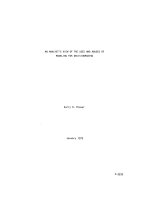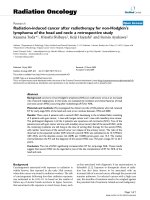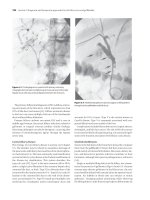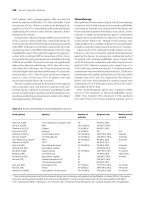Ebook Sherlock’s diseases of the liver and biliary system (13/E): Part 1
Bạn đang xem bản rút gọn của tài liệu. Xem và tải ngay bản đầy đủ của tài liệu tại đây (9.11 MB, 966 trang )
Table of Contents
Cover
Preface to the Thirteenth Edition
Preface to the First Edition
Chapter 1: Anatomy and Function
Development of the liver and bile ducts
Anatomy of the liver
Functional liver anatomy: sectors and segments
Anatomical abnormalities of the liver
Anatomy of the biliary tract (Fig. 1.6)
Surface marking (Fig. 1.7, Fig. 1.8)
Methods of examination
Microanatomy of the liver
Hepatic ultrastructure (electron microscopy) and organelle
functions
Functional heterogeneity of the liver (Fig. 1.20)
Dynamics of the hepatic microenvironment in physiology
and disease (Fig. 1.21)
Hepatocyte death and regeneration (Fig. 1.22)
References
Chapter 2: Liver Function in Health and Disease
Bilirubin metabolism (see Chapter 13)
Bile acids
Lipid and lipoprotein metabolism
Amino acid metabolism
Plasma proteins
Carbohydrate metabolism
Markers of hepatocellular injury: the serum transaminases
Markers of cholestasis: alkaline phosphatase (ALP) and
gamma glutamyl transferase (GGT)
Haematology in liver disease
2
Effects of ageing on the liver
References
Chapter 3: Biopsy of the Liver
Selection and preparation of the patient
Techniques
Risks and complications
Sampling variability
Naked eye appearances
Preparation of the specimen
Interpretation: a stepwise diagnostic approach
Indications (Table 3.4) [5]
Special methods [34]
References
Chapter 4: Coagulation in Cirrhosis
Introduction
Normal coagulation pathways: a hepatologist’s perspective
The coagulation system in cirrhosis
Bleeding and thrombosis in cirrhosis
Clinical laboratory tests of the coagulation system in cirrhosis
Conclusion
References
Chapter 5: Acute Liver Failure
Definition
Epidemiology and aetiologies (Fig. 5.1, Table 5.1)
Clinical features
Initial investigations
Complications and management of acute liver failure
Specific therapies
Prognosis
Liver transplantation (Chapter 37)
Conclusion
References
3
Chapter 6: Hepatic Fibrogenesis
Introduction
Natural history of hepatic fibrosis
Cellular and molecular features of hepatic fibrosis (Fig. 6.2)
Clinical aspects of hepatic fibrosis
Emerging antifibrotic targets and strategies
References
Chapter 7: Non invasive Assessment of Fibrosis and Cirrhosis
Introduction
The use of invasive and non invasive tests
Non invasive tests: specifics
Conclusions
References
Chapter 8: Hepatic Cirrhosis
Definition
Causes of cirrhosis
Anatomical diagnosis
Reversible cirrhosis
Clinical cirrhosis: compensated versus decompensated
Prognosis (Child–Pugh score, MELD, UKELD)
Clinical and pathological associations
Management
Acute on chronic liver failure
References
Chapter 9: Ascites
Mechanisms of ascites formation
Clinical features
Differential diagnosis
Spontaneous bacterial peritonitis (Table 9.3)
Treatment of cirrhotic ascites
Hyponatraemia
Refractory ascites
4
Hepatorenal syndrome
Prognosis
References
Chapter 10: Hepatic Encephalopathy in Patients with Cirrhosis
Clinical Features [1–3]
Classification [2,4]
Prevalence and consequences
Diagnosis [30]
Diagnostic comorbidities, confounders, and alternatives
Pathogenesis
Management [4]
Prevention [4]
References
Chapter 11: Portal Hypertension in Cirrhosis
Introduction
Pathophysiology and rational basis of therapy
Evaluation and diagnosis
Natural history and prognosis
Management
Treatment of portal hypertension according to clinical
scenarios
References
Chapter 12: Vascular Disorders of the Liver and Extrahepatic
Portal Hypertension
Hepatic artery occlusion
Aneurysms of the hepatic artery
Hepatic arterioportal fistula
Hepatic vascular malformations in hereditary haemorrhagic
telangiectasia
Congenital portosystemic shunts – Abernethy malformation
Budd–Chiari syndrome – hepatic venous outflow tract
obstruction
5
Extrahepatic portal vein obstruction – portal vein thrombosis
and portal cavernoma in the absence of cirrhosis
Portal vein thrombosis in patients with cirrhosis
Idiopathic non cirrhotic intrahepatic portal hypertension
Hypoxic hepatitis
Congestive cardiac hepatopathy
Non obstructive sinusoidal dilation (NOSD) and peliosis
References
Chapter 13: Jaundice and Cholestasis
Introduction
Mechanics of bile formation
Syndrome of cholestasis
Causes of isolated hyperbilirubinaemia
Causes of cholestatic and hepatocellular jaundice
Bile duct and hepatocellular diseases
Consequences of cholestasis and their management
Investigation of the jaundiced patient
Decisions to be made in the jaundiced patient
Management of cholestatic disorders
References
Chapter 14: Gallstones and Benign Biliary Disease
Introduction
Imaging the gallbladder and biliary tract
Gallstones
Symptoms and complications of gallstones
Cholecystectomy
Complicated acute gallbladder disease
Percutaneous cholecystostomy
Asymptomatic gallbladder stones
Non surgical treatment of gallstones in the gallbladder
Common bile duct stones
Acute gallstone pancreatitis
6
Large common duct stones
Mirizzi syndrome
Intrahepatic gallstones
Haemobilia
Functional gallbladder and sphincter of Oddi disorders
Other gallbladder pathologies
Relationships to malignant change
Benign biliary strictures
Anastomotic strictures following biliary surgery
IgG4 related sclerosing cholangitis
Chronic pancreatitis
References
Chapter 15: Malignant Biliary Diseases
Carcinoma of the gallbladder
Carcinoma of the bile duct (cholangiocarcinoma)
Other biliary malignancies
Metastases at the hilum
Ampullary and periampullary carcinomas
Conclusion
References
Chapter 16: Fibropolycystic Liver Diseases and Congenital
Biliary Abnormalities
Overview
Polycystic liver disease
Fibropolycystic diseases
Autosomal recessive polycystic kidney disease
Congenital hepatic fibrosis
Caroli disease [58]
Microhamartomas (von Meyenberg complexes)
Choledochal cysts
Solitary non parasitic liver cyst
Congenital anomalies of the biliary tract
7
References
Chapter 17: Primary Biliary Cholangitis
Clinical features
Diagnosis
Epidemiology
Aetiology and pathogenesis
Management
Prognosis
References
Chapter 18: Sclerosing Cholangitis
Introduction
Primary sclerosing cholangitis
Secondary sclerosing cholangitis
Sclerosing cholangitis in systemic inflammatory diseases
References
Chapter 19: Autoimmune Hepatitis and Overlap Syndromes
Introduction
Disease overview
Biological determinants of disease
Disease presentation
Laboratory features
Imaging
Liver biopsy and histological features
Differential diagnosis
Diagnostic dilemmas
Making a diagnosis in practice
Management strategies
Pretreatment and on treatment considerations
Treatment challenges and alternative agents
Pregnancy and autoimmune hepatitis
The elderly and autoimmune hepatitis
Childhood onset autoimmune hepatitis
8
Autoimmune hepatitis and liver transplantation
Overlap syndromes
Conclusion
References
Chapter 20: Enterically Transmitted Viral Hepatitis
General features of enterically transmitted viral hepatitis
Hepatitis A virus
Hepatitis E virus
References
Chapter 21: Hepatitis B
Introduction
Hepatitis B virus
Immune response and mechanisms of hepatic injury
Epidemiology
Prevention
Diagnosis
Clinical manifestations
Natural history
Treatment
HBV and HCV coinfection (also see Chapter 23)
HBV and HDV coinfection
HBV and HIV coinfection
References
Chapter 22: Hepatitis D
History
Hepatitis D virus (Table 22.1)
Epidemiology
Pathogenesis
Modes of infection and clinical course
Diagnosis
Treatment
Prevention
9
References
Chapter 23: Hepatitis C
Introduction
Epidemiology
Virology
Pathology and pathogenesis
Diagnostic tests for hepatitis C
Acute hepatitis C
Chronic hepatitis C
References
Chapter 24: Drug Induced Liver Injury
Introduction
Epidemiology
Complications of DILI
Classification of hepatotoxicity
Drug metabolism and pharmacokinetics
Hepatic drug metabolism
Molecular mechanisms in drug induced liver injury
Non genetic risk factors for DILI
Diagnosis of DILI
Medical management
Pharmacogenetic risk factors
Potential immunological mechanisms in idiosyncratic DILI
Liver injury from specific drugs
References
Chapter 25: Alcohol and the Liver
Introduction
Alcohol metabolism
Pathogenesis
Susceptibility
Histological features
Clinical features
10
Clinical syndromes
Prognosis
Treatment
Conclusions
References
Chapter 26: Iron Overload States
Normal iron physiology
Iron overload and liver damage
Genetic haemochromatosis
Other iron storage diseases
References
Chapter 27: Wilson Disease
Molecular genetics: pathogenesis
Pathology
Clinical picture
Laboratory tests
Genetic strategies
Diagnostic difficulties
Treatment (Table 27.1)
Prognosis
Non Wilsonian copper related cirrhosis
References
Chapter 28: Non Alcoholic Fatty Liver Disease
Introduction
Further definitions, terminology, and diagnosis
Liver biopsy, classification of NAFLD, and non invasive
markers of NASH and fibrosis
Clinical features
Laboratory testing
Epidemiology
Ethnic variation in NAFLD
Pathogenesis of NASH
11
Natural history of NAFLD (Fig 28.9)
NAFLD and hepatocellular carcinoma (HCC)
Therapy for non alcoholic fatty liver disease
Other forms of NAFLD
References
Chapter 29: Nutrition and Chronic Liver Disease
Introduction
Epidemiology and general characteristics
Causes of malnutrition
Consequences of malnutrition
Diagnosis and assessment
Treatment and management
References
Chapter 30: Pregnancy and the Liver
Introduction
Normal physiology in pregnancy
Pregnancy related liver diseases
Pre existing liver diseases and pregnancy
Liver transplantation and pregnancy
Liver disease coincidentally arising with pregnancy
Conclusion
References
Chapter 31: The Liver in the Neonate, in Infancy, and Childhood
Investigation of liver disease in children
Neonatal jaundice
Neonatal unconjugated hyperbilirubinaemia (Tables 31.2,
31.3)
Neonatal liver disease (conjugated hyperbilirubinaemia)
Neonatal hepatitis
Inherited disease in the neonate
Genetic cholestatic syndromes
Structural abnormalities: biliary atresia and choledochal cyst
12
Acute liver failure in infancy
Liver disease in older children
Metabolic disease in older children
Cirrhosis and portal hypertension
Liver transplantation
Tumours of the liver (see also Chapters 35 and 36)
References
Chapter 32: The Liver in Systemic Diseases
Collagen vascular and autoimmune disorders
Hepatic granulomas
Sarcoidosis
The liver in endocrine disorders
Amyloidosis
Porphyrias
The liver in haemolytic anaemias
The liver in myelo and lymphoproliferative disease [102]
Bone marrow transplantation
Lymphoma
Extramedullary haemopoiesis
Rare haematological disorders that may involve the liver
Lipid storage diseases
Non metastatic complications of malignancy
References
Chapter 33: The Liver in Infections
Introduction
Jaundice of infections
Pyogenic liver abscess
Hepatic amoebiasis
Tuberculosis of the liver
Hepatic actinomycosis
Syphilis of the liver
Perihepatitis
13
Leptospirosis
Relapsing fever
Lyme disease
Rickettsial infections
Fungal infections
Schistosomiasis (bilharzia)
Malaria [113]
Kala azar (visceral leishmaniasis)
Echinococcosis (hydatid disease)
Ascariasis
Strongyloides stercoralis
Trichinosis
Toxocara canis (visceral larva migrans)
Liver flukes
References
Chapter 34: Imaging of the Liver and Diagnostic Approach of
Space Occupying Lesions
Ultrasound
Computed tomography
Magnetic resonance imaging
Radioisotope scanning
Positron emission tomography
MR spectroscopy
Conclusions and choice of imaging technique
References
Chapter 35: Benign Liver Tumours
Diagnosis of focal liver lesions
Hepatocellular lesions
Biliary and cystic lesions
Mesenchymal tumours
References
Chapter 36: Primary Malignant Neoplasms of the Liver
14
Hepatocellular carcinoma
Intrahepatic cholangiocarcinoma
Other malignant neoplasms of the liver
Other sarcomas
References
Chapter 37: Hepatic Transplantation
Selection of patients (Table 37.1)
Candidates (Table 37.2)
Absolute and relative contraindications (Table 37.4)
General preparation of the patient
Donor selection and operation
The recipient operation (Fig. 37.3)
Immunosuppression
Postoperative course
Post transplantation complications (Table 37.9)
Conclusion
Acknowledgement
References
Chapter 38: Hepatic Transplantation and HBV, HCV, and HIV
Infections
Introduction
Hepatitis B and liver transplantation
Hepatitis C and liver transplantation
HIV and liver transplantation
References
Index
End User License Agreement
List of Tables
Chapter 02
Table 2.1 Quantitative liver function tests
15
Table 2.2 Blood tests in hepatobiliary disease
Table 2.3 Properties of lipoproteins
Table 2.4 Serum (plasma) proteins synthesized by the liver
Chapter 03
Table 3.1 History of liver biopsies
Table 3.2 Indications for transjugular liver biopsy
Table 3.3 Fatalities from needle liver biopsy
Table 3.4 Indications for liver biopsy
Chapter 04
Table 4.1 Important terms and concepts in coagulation of
cirrhosis
Table 4.2 Components of coagulation
Table 4.3 Alterations of coagulation system in cirrhosis
Chapter 05
Table 5.1 Causes of acute liver failure
Table 5.2 Some drugs that may cause idiosyncratic acute liver
failure
Table 5.3 Investigations of acute liver failure
Table 5.4 Intensive care of acute liver failure
Table 5.5 King’s College Hospital criteria for liver
transplantation in acute liver failure [72]
Chapter 07
Table 7.1(a) Serum markers of fibrosis: derivation of score
where appropriate (see pp. 98 and 99 for abbreviations)
Table 7.1(b) Performance of common serum markers of
fibrosis
Chapter 08
Table 8.1 Aetiology and definitive treatment of cirrhosis
Table 8.2 General investigations in the patient with cirrhosis
(see also Table 9.1)
16
Table 8.3 Child–Pugh staging system. Child A class is 5 and 6
points; B is 7–9 points; and C is 10–15 points
Table 8.4 Pulmonary changes complicating chronic
hepatocellular disease
Table 8.5 Hepatopulmonary syndrome
Table 8.6 Diagnostic criteria for acute on chronic liver
failure using the CLIF Organ Failure score
Table 8.7 Table illustrating the dynamic nature of ACLF
Chapter 09
Table 9.1 Circulatory changes in patients with cirrhosis
Table 9.2 Differential diagnosis among the three most
common causes of ascites
Table 9.3 Spontaneous bacterial peritonitis
Table 9.4 General management of ascites
Table 9.5 Advice for ‘no added salt diet’ (70–90 mmol/day or
1.5–2.0 g/day)
Table 9.6 Therapeutic paracentesis as initial treatment of
ascites
Table 9.7 Hyponatraemia
Table 9.8 Treatment of refractory ascites
Table 9.9 Criteria for diagnosis of hepatorenal syndrome
Table 9.10 Iatrogenic causes of acute kidney injury in
cirrhosis
Table 9.11 Vasoconstrictors in HRS: doses used and adverse
events
Chapter 10
Table 10.1 West Haven criteria for grading mental status in
patients with cirrhosis
Table 10.2 Factors which may precipitate hepatic
encephalopathy in patients with cirrhosis
Table 10.3 The Glasgow Coma Score [32]
17
Table 10.4 Guidelines for the diagnosis of hepatic
encephalopathy in patients with cirrhosis
Table 10.5 Patterns of cognitive dysfunction observed in
patients with hepatic encephalopathy and in several other
potentially confounding disorders
Table 10.6 Management of recurrent or episodic hepatic
encephalopathy
Table 10.7 Management of persistent hepatic encephalopathy
Table 10.8 Management of minimal hepatic encephalopathy
Table 10.9 Nutritional management of patients with hepatic
encephalopathy
Chapter 11
Table 11.1 Classification and aetiology of portal hypertension:
haemodynamic characteristics, imaging, and elastographic
findings
Table 11.2 New targets for the pharmacological treatment of
portal hypertension
Table 11.3 Available non invasive methods to assess the
presence of clinically significant portal hypertension (CSPH)
in cirrhosis in clinical practice
Table 11.4 Baveno VI recommendations regarding screening
and surveillance of gastro oesophageal varices in cirrhosis
(the grade of evidence is given at the end of each statement)
Table 11.5 Drugs used in clinical practice for treating portal
hypertension in cirrhosis
Table 11.6 Management of portal hypertension according to
the stage of cirrhosis
Chapter 12
Table 12.1 Conditions associated with primary Budd–Chiari
syndrome (BCS) and portal vein thrombosis (PVT)
Table 12.2 Conditions reported in association with idiopathic
non cirrhotic portal hypertension
Table 12.3 Conditions reported in association with non
18
obstructive sinusoidal dilation
Chapter 13
Table 13.1 Transporters involved in transport of bilirubin,
bile salts and phospholipid and the formation of bile
Table 13.2 Dietary management, vitamins and supportive
medication in the management of patients with cholestatic
liver disease (TAG, triacylglycerides)
Table 13.3 Stepwise medical treatment of pruritus
Chapter 14
Table 14.1 Benign biliary diseases
Table 14.2 Classification of gallstones
Table 14.3 Factors in cholesterol stone formation
Table 14.4 Non surgical treatments for gallbladder stones
Table 14.5 Non surgical treatment options for large
common duct stones
Table 14.6 Causes of benign biliary stricture
Table 14.7 Classification of benign biliary strictures
Chapter 16
Table 16.1 Inherited fibrocystic diseases of the liver: clinical
presentation and associated renal disorders
Table 16.2 Malformation syndromes reported with liver
histological changes resembling those of congenital hepatic
fibrosis [56]
Table 16.3 A classification of congenital anomalies of the
biliary tract
Chapter 17
Table 17.1 Diagnosis of primary biliary cholangitis at
presentation
Table 17.2 Differential diagnosis of primary biliary
cholangitis
Table 17.3 Genetic loci associated with PBC in genome wide
19
association studies and other related approaches at
genome wide level of significance (p < 5 × 10−8). Data are
given for the UK PBC patient cohort and related meta
analyses [53–55]
Chapter 18
Table 18.1 Causes of secondary sclerosing cholangitis (SSC),
and ‘mimics’ of primary sclerosing cholangitis (PSC)
Table 18.2 Autoimmune conditions observed in patients with
primary sclerosing cholangitis (PSC) [7]
Table 18.3 Possible pathogenetic mechanisms for primary
sclerosing cholangitis. These hypotheses are not mutually
exclusive
Table 18.4 Diagnostic criteria for recurrent primary
sclerosing cholangitis (PSC) following liver transplantation
[76] (confirmed diagnosis of PSC prior to liver
transplantation is a prerequisite)
Chapter 19
Table 19.1 Differential diagnosis for elevated transaminase
activity
Table 19.2 Clinical differences between serological
classifications of autoimmune hepatitis
Table 19.3 Autoantibodies commonly associated with chronic
liver disease
Table 19.4 Drugs implicated in precipitating an
autoimmune like hepatitis
Table 19.5 Revised diagnostic criteria for autoimmune
hepatitis [35]
Table 19.6 Simplified criteria for diagnosing autoimmune
hepatitis [27]
Table 19.7 Broad overview of initial regimens commonly used
for treating autoimmune hepatitis
Table 19.8 Notable side effects of the common medications
used in autoimmune liver disease
20
Table 19.9 Common practice pre
corticosteroids ± azathioprine
and on treatment with
Table 19.10 General measures in patients with autoimmune
liver disease
Table 19.11 Pregnancy and autoimmune hepatitis
Table 19.12 Summary features of autoimmune liver disease
demonstrating traditional descriptions
Chapter 20
Table 20.1 Viral hepatitis A, B, C, D, and E contrasted
Table 20.2 Groups for which the hepatitis A vaccine is
recommended by CDC (2006 and 2017)
Chapter 21
Table 21.1 Patterns of HBV infection
Table 21.2 Indications for hepatitis B vaccination
Table 21.3 Hepatitis B vaccines and dosage recommendations
Table 21.4 Causes of non response to HBV vaccine
Table 21.5 Interpretation of HBV serological markers
Table 21.6 Diagnosis of HBV infection
Table 21.7 Recommendations on who should be screened for
HBV
Table 21.8 Factors associated with increased risk of cirrhosis
or hepatocellular carcinoma
Table 21.9 Prediction models for hepatocellular carcinoma
Table 21.10 Response rates to approved therapies for
HBeAg positive and HBeAg negative chronic hepatitis B
Table 21.11 Indications for hepatitis B treatment
Table 21.12 Advantages and disadvantages of interferon and
nucleos(t)ide analogue therapies
Chapter 22
Table 22.1 Characteristics of hepatitis D virus (HDV)
21
Table 22.2 Hepatitis D: significance of serological and
virological markers
Table 22.3 Diagnosis of acute and chronic hepatitis D
Chapter 23
Table 23.1 Groups at risk of HCV infection
Table 23.2 Approved direct acting antivirals in current use
Table 23.3 Drug–drug interactions with commonly using
immunosuppressants
Table 23.4 IFN free combination treatment regimens
available as options for each HCV genotype
Table 23.5 Current treatment options for genotype 1 IFN
treatment naïve or experienced patients with or without
cirrhosis
Table 23.6 Current treatment options for genotype 2 IFN
treatment naïve or experienced patients with or without
cirrhosis
Table 23.7 Current treatment options for genotype 3 IFN
treatment naïve or experienced patients with or without
cirrhosis
Table 23.8 Current treatment options for genotype 4 IFN
treatment naïve or experienced patients with or without
cirrhosis
Table 23.9 Current treatment options for genotype 5 or 6 IFN
treatment naïve or experienced patients with or without
cirrhosis
Table 23.10 Recent clinical trials of second
therapy
generation DAA
Table 23.11 AASLD guidelines on recommendations for
patients with renal impairment
Table 23.12 Control of hepatitis C
Chapter 24
Table 24.1 Prospective registry studies of DILI patients
Table 24.2 Recent FDA regulatory actions regarding
22
hepatotoxicity of prescription drugs and selective herbal and
dietary supplement (HDS) products
Table 24.3 Diagnostic approach to patients with suspected
drug induced liver injury
Table 24.4 Expressions of drug induced liver injury
Table 24.5 The Drug Induced Liver Injury Network
(DILIN) grading system for causality assessment
Table 24.6 The Drug Induced Liver Injury Network
(DILIN) grading system for liver disease severity
Table 24.7 Genome wide association studies of DILI
susceptibility
Table 24.8 Clinical features of recent reports of patients with
hepatotoxicity from herbal and dietary supplement (HDS)
products
Table 24.9 Single herbal products and herbal mixtures
reported to cause liver injury
Chapter 25
Table 25.1 Possible hepatotoxic effects of acetaldehyde
Table 25.2 Alcoholic hepatitis histology score (AHHS) (poor
prognosis if score >5)
Table 25.3 Alcohol use disorders identification test (AUDIT)
questionnaire
Table 25.4 Liver biopsy in alcohol
related liver disease
Table 25.5 Treatments for alcohol dependence
Table 25.6 Treatments for alcohol related hepatitis
Chapter 26
Table 26.1 Causes of inherited hepatic iron overload
Table 26.2 Causes of hepatic iron overload from
haematological, hepatic, and other sources
Table 26.3 Lessons from the Haemochromatosis and Iron
Overload Screening (HEIRS) study [60]
Chapter 27
23
Table 27.1 Treatment of Wilson disease
Chapter 28
Table 28.1 The spectrum of NAFLD
Table 28.2 National Cholesterol Education Program: Adult
Treatment Program III (NCEP ATP III) Guidelines –
metabolic syndrome components
Table 28.3 Fibrosis staging in non alcoholic steatohepatitis
Table 28.4 Emerging therapies for the treatment of NASH
Chapter 29
Table 29.1 Consequences of malnutrition, sarcopenia, and
overnutrition in advanced liver disease
Table 29.2 Nutritional assessment in patients with cirrhosis
Table 29.3 Parameters included in Subjective Global
nutritional Assessment (SGA) and in Royal Free Hospital
Subjective Global nutritional Assessment (RFH SGA)
Table 29.4 Standard nutritional approach in a patient with
cirrhosis
Chapter 30
Table 30.1 Classification of liver disease and pregnancy
Table 30.2 Characteristic features and laboratory indices in
the pregnancy specific liver disorders
Table 30.3 Swansea diagnostic criteria for the diagnosis of
acute fatty liver of pregnancy
Table 30.4 Adverse outcomes in pregnant women with
cirrhosis
Chapter 31
Table 31.1 Approximate mean liver span of infants and
children based on four studies on 470 subjects [4]
Table 31.2 Investigations of the jaundiced newborn
Table 31.3 Unconjugated hyperbilirubinaemia in neonates
related to time of onset
24
Table 31.4 Conjugated hyperbilirubinaemia in neonates
Table 31.5 Genetic cholestatic syndromes
Table 31.6 The hepatic glycogen storage diseases
Chapter 32
Table 32.1 Diagnostic tests for some diseases with hepatic
granulomas
Table 32.2 Hepatic granulomas associated with infections
Table 32.3 Hepatic granulomas in patients with advanced
HIV infection
Table 32.4 Important causes of granulomatous drug
reactions
Table 32.5 Classification of amyloidosis of particular hepatic
relevance
Table 32.6 Types of porphyria
Table 32.7 Hepatobiliary disease and bone marrow
transplantation
Table 32.8 Features of jaundice in lymphoma
Chapter 33
Table 33.1 Organisms commonly isolated from pyogenic liver
abscesses
Table 33.2 The differential diagnosis of Weil disease from
viral hepatitis during the first week of illness
Table 33.3 Classification of ultrasound appearances in
hydatid disease by WHO – Informal Working Group on
Echinococcosis (WHO IWGE) [128]
Table 33.4 Treatment of hydatid liver cysts – the PAIR
technique
Chapter 35
Table 35.1 Benign liver tumours and pseudotumours
Table 35.2 Hepatocellular adenoma – classification and
features
25









